flagState.
Migrate a public app to the developer projects framework
Using the CLI, you’ll migrate an existing production public app to the projects framework. App features that are supported by projects, such as auth configuration and webhooks, will be included automatically in the migration.Prerequisites
This guide assumes that you meet the following criteria:- You have an existing public app that has not yet been converted to the developer projects framework.
- You’ve opted your developer account into the new developer overview, or you’re using a standard HubSpot account to manage your apps (which automatically uses the new developer overview).
- You are ready to migrate your public app to the developer projects framework, enabling the creation of UI extensions for your app. If you want to start with a dry run of the migration, you can instead make a copy of your app in a project by running
hs project clone-app. - You have set up your local environment for project development and set your developer account as the default in the CLI.
- To view your connected accounts, run
hs accounts listin the terminal. The terminal will list all currently connected accounts, along with the default. - If your developer account is connected but not the default, run
hs accounts use <accountNameOrID>.
- To view your connected accounts, run
Migrate legacy public app to the projects framework
To begin migration, you’ll switch your public app to be configured using projects. This process will preserve the original auth credentials, and all other existing app features, App Marketplace listings, and app installs. No changes are required in your app backend, and customers will not experience any interruptions in service.- Ensure you’ve installed the latest version (v7.6.0 or greater) of the HubSpot CLI by running the following command:
- With your developer account connected to the CLI and set as the default, run the command below:
- Select the public app that you’d like to migrate. This will create a new project containing a single public app component that represents the current state of your app.
- Enter a name and local path for your project, then press Enter. The terminal will then display a message to outline the migration process and confirm your intention to convert the app.
- Press Enter to confirm that you’re ready to proceed with migration.
- The migration process will then begin, and the terminal will display the migration status. The migration includes:
- Creating the project in your HubSpot account.
- Converting the project-supported features of the app to source code files, which you can use int he future to update feature configuration.
- Building and deploying the new project (Build #1), which completes the association between the public app and its project. This will preserve the original auth credentials, all app features, App Marketplace listing, and installs.
- Downloading the new project source files to the specified local directory.
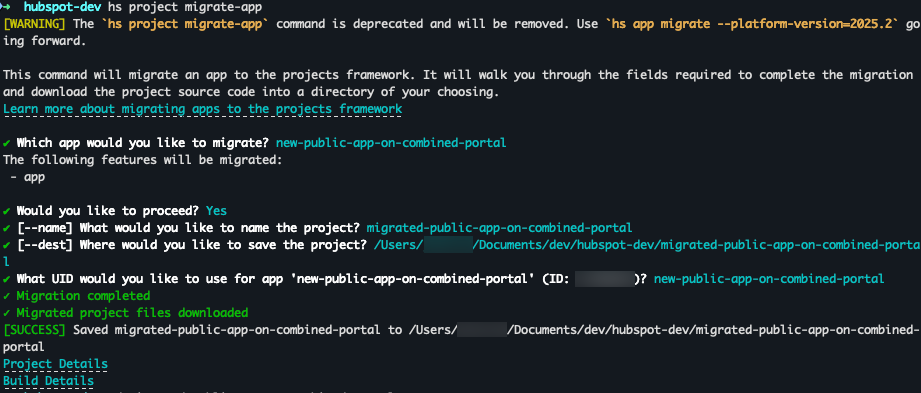
hs project deploy --buildId=1 command.
Before you can begin UI extension development and run a local development server, deploy the successful build by running hs project deploy.
Workflow for HubSpot Marketplace apps
If your app is listed on the HubSpot Marketplace, your migrated app will automatically have a feature flag enabled that controls access to app cards in the accounts where the app is installed. You’ll need to use the feature flag API to selectively enable accounts to use the new app cards. By default, app cards for listed public apps are restricted to a maximum of five accounts.Development workflow
1
Set test account feature flag
To start developing new app cards without impacting production accounts, first create a test account within your developer account if you haven’t done so yet. Then, using your developer account’s developer API key, set your test account’s feature flag to With your test account feature flag configured, you’ll be able to view new app cards in HubSpot as you develop your UI extensions.
ON by making a POST request to the feature flag API.2
Begin local development
- Start the local development server by running the following command:
- Select your developer test account, then press Enter. The terminal will update with a message displaying the status of the development server. You can press q at any time to end the server.
- When you’re satisfied with your updates, upload your changes to your developer account.
- When the build succeeds, deploy your changes by running the command below:
Alternatively, you can run both upload and deploy commands at the same time by running
hs project upload && hs project deploy. You can also enable automatic deploy on successful build in the project’s settings in your HubSpot account.3
Continue testing and submit for review
You can continue testing your app and its new cards in additional accounts by using the feature flag API to set the Once you’ve sufficiently tested your updated app, you’ll need to submit it for review by emailing the following required information to app-card-review@hubspot.com:
flagState to ON, as shown in the first step above. You can enable this flag for up to five accounts, including beta customers.If at any point you want to start over, you can always safely revert the app by redeploying build #1 with the
hs project deploy --buildId=1 command.- Production app ID
- Build ID
- Hub ID of your developer account
- Hub ID of the test account where the app is installed
- Credentials or access to any third-party platform necessary to test the app card, if applicable
- Demo video or detailed instructions of how users will interact with the card (such as a quick Loom)
- Additional context or details HubSpot might need that aren’t covered by the above
app-card-review@hubspot.com as a user to your test account where the app is installed. Grant this user all the permissions necessary to fully test your app cards (for simplicity, Super Admin is recommended). A member of the review team will then test your app card and provide feedback if changes are needed. You’ll continue to work with app-card-review@hubspot.com to address provided feedback until all additional app card criteria are met.Once your app is approved, you can begin distributing it in the App Marketplace, and you will not need to resubmit it for approval when making future changes.4
Distribute to the App Marketplace
After receiving approval for unlimited distribution from the App Card marketplace review process, your app will be ready for distribution. Before proceeding with app distribution, it’s recommended to consider the following:
- If your app previously included a legacy CRM card in the sidebar, consider adding card update guidance so that users can seamlessly add your new cards and remove the old ones.
- It’s recommended to gradually roll out your app card updates to catch any issues before distributing to the full install base. You can also roll out to all installed accounts at the same time.
- As your install base begins using your new app cards, you can hide legacy CRM cards from the onboarded accounts. The final step of migration is to delete the old cards from the app.
Rollout strategies
Add card update guidance
To help users migrate to your new cards, HubSpot includes a default update state that you can apply to your classic cards. This update includes messaging to indicate that the card has available updates. For account admins, a link to the app’s settings page will be included. Non-admin users will see similar messaging, but will be guided to contact their account admin to assist with setup.| Admin view | Non-admin view |
|---|---|
 |  |
"showMigrationMessage": "true" in the card’s JSON response. This should be included at the top-level of the response.
- In the test account, navigate to a CRM record that contains your classic card.
-
On the CRM record, locate the card, then click the Set up now link to navigate to the app settings page.
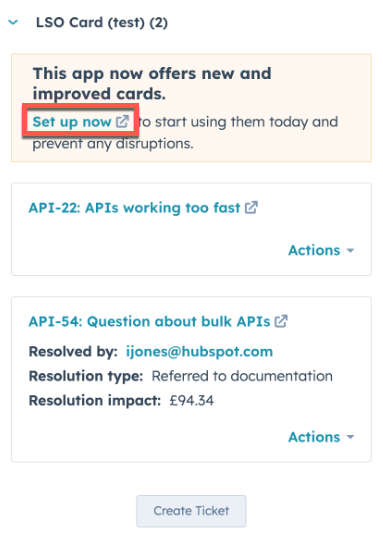
- The app settings page will display all available cards. Click the link provided for each card to navigate to the customization page for that object.
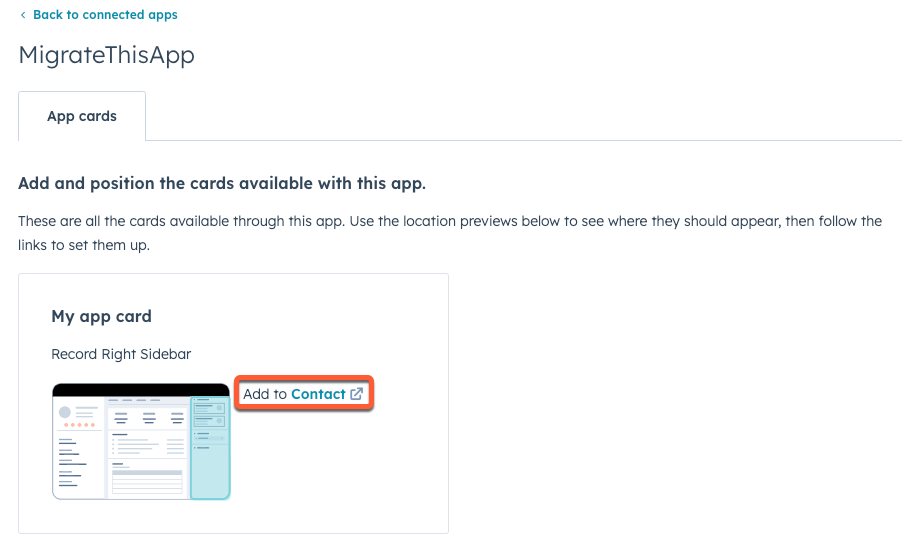
- Users can then proceed to customize their record pages as needed. They can find your new cards within the Apps section of the customization sidebar.
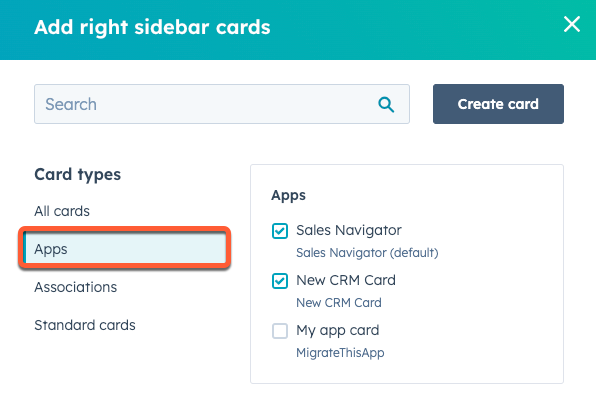
-
After adding the new card, the old card can be removed by locating it in the view editor then clicking Remove. Alternatively, you can hide the old card from the account using the feature flag API.
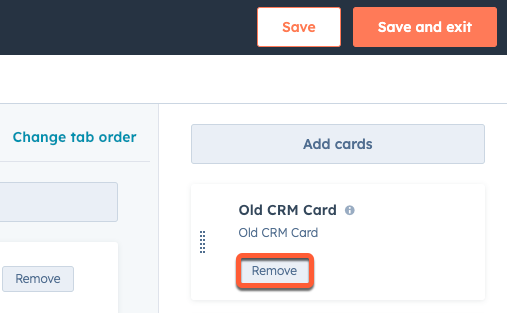
Gradually roll out app cards
Using the feature flag API endpoints, you can gradually roll out your app in two ways:Roll out to new installs
To roll out your app cards to new installs only, you’ll use the feature flag API to turn off thehs-release-app-cards feature flag for all existing installs. Then, you’ll switch the flag’s state to ON so that new installs have the flag enabled by default.
- For the first request, set the
flagStatetoOFFfor all accounts that currently have the app installed. You’ll need to gather theportalIdfor all existing installed accounts, then make aPOSTrequest tohttps://api.hubapi.com/feature-flags/v3/{appId}/flags/hs-release-app-cards/portals/batch/upsert?hapikey={developerAPIKey}.
- JSON
- cURL
- With existing app installs set to
OFF, you can now set thedefaultStatetoON. To do so, make aPUTrequest tohttps://api.hubapi.com/feature-flags/v3/{appId}/flags/hs-release-app-cards?hapikey={developerAPIKey}
- JSON
- cURL
- Once you feel confident in new customer adoption, you can begin to remove customer
portalIdsthat you switched to theOFFstate by making aPOSTrequest tohttps://api.hubapi.com/feature-flags/v3/{appId}/flags/hs-release-app-cards/portals/batch/delete?hapikey={developerAPIKey}with the account IDs you want to remove from theOFFlist.
- JSON
- cURL
To check which accounts still have their flag set to
OFF, you can make a GET request to `/feature-flags/v3//flags/hs-release-app-cards/portals/. Learn more in the feature flag API reference documentation.- When all previously added accounts have been deleted using the above endpoint, you”ll have successfully completed the rollout and finished migration. At this point, you can safely delete your feature flag by making a
DELETErequest tohttps://api.hubapi.com/feature-flags/v3/{appId}/flags/hs-release-app-cards?hapikey={developerAPIKey}.
Roll out to a subset of accounts
Alternatively, rather than starting with new installs, you can selectively enable your app cards for a subset of accounts that have your app installed. To do so, you’ll need to have a list of the account IDs for all existing public app installs. With that list, you can make aPOST request to https://api.hubapi.com/feature-flags/v3/{appId}/flags/hs-release-app-cards/portals/batch/upsert?hapikey={developerAPIKey} and set their flagState to ON.
- JSON
- cURL
DELETE request to https://api.hubapi.com/feature-flags/v3/{appId}/flags/hs-release-app-cards?hapikey={developerAPIKey}.
Roll out to all accounts simultaneously
To release your app cards to all installed accounts simultaneously, delete the app’s feature flag by making aDELETE request to https://api.hubapi.com/feature-flags/v3/{appId}/flags/hs-release-app-cards?hapikey={developerAPIKey}.
Hiding legacy CRM cards
In addition to using the feature flags API to roll out app cards to your install base, you can also use it to facilitate the removal of legacy CRM cards by setting thehs-hide-crm-cards flag. For example, for existing installs, you may want to continue showing the old cards to remind users to upgrade to your new cards, but then hide them from new installs and accounts that have upgraded.
To use the hs-hide-crm-cards flag to manage legacy CRM card access:
- Make a
PUTrequest to set your app’sdefaultStatetoOFF. This initializes the app flag and ensures that the app’s legacy CRM cards will be visible in every existing and new installed account.
- JSON
- cURL
- Next, set the
flagStatetoOFFfor all accounts that currently have the app installed. In the request body, you’ll provide aportalIdfor each account.
- JSON
- cURL
- With existing app installs set to
OFF, make another request to set thedefaultStatetoON. This prevents new installs from ever seeing the app’s legacy CRM cards.
- As you observe customers using the new app cards, such as receiving
hubspot.fetch()calls from their accounts, you can remove them from thehs-hide-crm-cardsflag list using the request below. Because you hid the legacy CRM cards from new installs, you’ll only need to take this step for accounts you previously set toOFF.
- JSON
- cURL
- When all previously added accounts have been removed from the flag list, you can be sure that your entire install base can no longer access the old legacy CRM cards. At this point, you can navigate to the app’s settings page in your developer account and delete the legacy CRM cards.
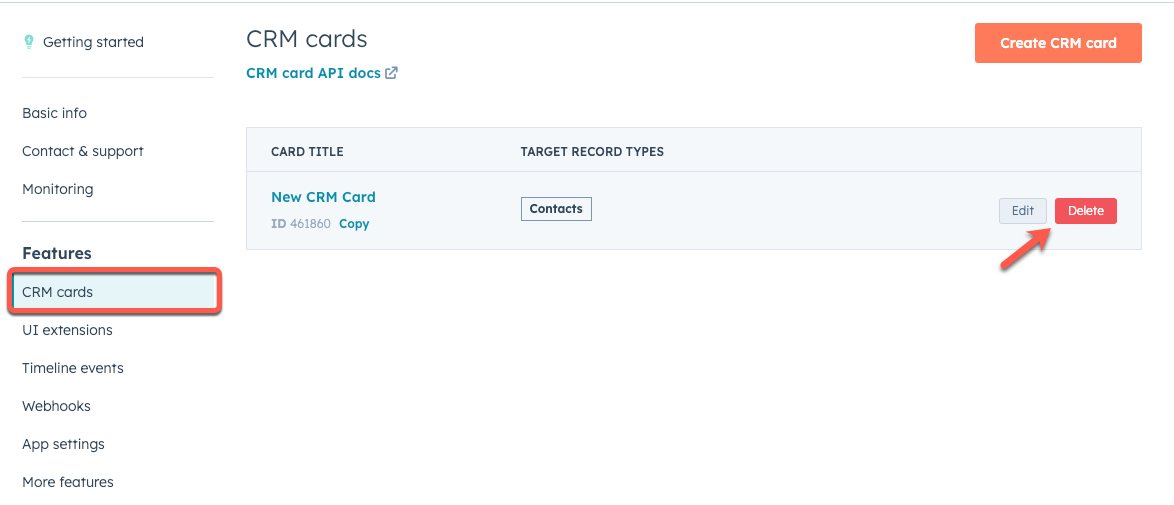
- Finally, make a request to delete the
hs-hide-crm-cardsflag from the app.
Feature flag API reference
Use the feature flag API to control availability of your app cards in customer accounts. All endpoints are under thehttps://api.hubapi.com/feature-flags/v3/{appId} root path. The API currently supports a single App Flag: hs-release-app-cards. Attempts to specify other App Flags will receive an error.
View the feature flag API reference endpoint documentation:
- App flag endpoints:
- Account flag state endpoints: